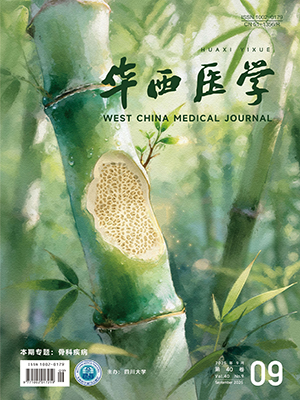| 1. |
Shabhay A, Horumpende P, Shabhay Z, et al. Clinical profiles of diabetic foot ulcer patients undergoing major limb amputation at a tertiary care center in North-eastern Tanzania. BMC Surg, 2021, 21(1): 34.
|
| 2. |
McCallon SK, Weir D, Lantis JC 2nd. Optimizing wound bed preparation with collagenase enzymatic debridement. J Am Coll Clin Wound Spec, 2015, 6(1-2): 14-23.
|
| 3. |
Ramundo J, Gray M. Enzymatic wound debridement. J Wound Ostomy Continence Nurs, 2008, 35(3): 273-280.
|
| 4. |
Hussein Ali E, Adnan SS. Effect of collagenase ointment versus moist exposed burn ointment on healing of full-thickness burns in mice by removing of necrotic tissue. Dermatol Ther, 2019, 32(1): e12769.
|
| 5. |
Shi L, Carson D. Collagenase Santyl ointment: a selective agent for wound debridement. J Wound Ostomy Continence Nurs, 2009, 36(Suppl 6): S12-S16.
|
| 6. |
Lantis Ii JC, Gordon I. Clostridial collagenase for the management of diabetic foot ulcers: results of four randomized controlled trials. Wounds, 2017, 29(10): 297-305.
|
| 7. |
Ayello EA, Cuddigan JE. Debridement: controlling the necrotic/cellular burden. Adv Skin Wound Care, 2004, 17(2): 66-75.
|
| 8. |
Radice M, Brun P, Bernardi D, et al. Clostridial collagenase releases bioactive fragments from extracellular matrix molecules. J Burn Care Rehabil, 1999, 20(4): 282-291.
|
| 9. |
Postlethwaite AE, Seyer JM, Kang AH. Chemotactic attraction of human fibroblasts to typeⅠ, Ⅱ, and Ⅲ collagens and collagen-derived peptides. Proc Natl Acad Sci USA, 1978, 75(2): 871-875.
|
| 10. |
Laskin DL, Kimura T, Sakakibara S, et al. Chemotactic activity of collagen-like polypeptides for human peripheral blood neutrophils. J Leukoc Biol, 1986, 39(3): 255-266.
|
| 11. |
Demidova-Rice TN, Geevarghese A, Herman IM. Bioactive peptides derived from vascular endothelial cell extracellular matrices promote microvascular morphogenesis and wound healing in vitro. Wound Repair Regen, 2011, 19(1): 59-70.
|
| 12. |
Galperin RC, Lange DL, Ramsay SJ, et al. Anti-inflammatory effects of clostridial collagenase results from in vitro and clinical studies. J Am Podiatr Med Assoc, 2015, 105(6): 509-519.
|
| 13. |
Das A, Datta S, Roche E, et al. Novel mechanisms of Collagenase Santyl Ointment (CSO) in wound macrophage polarization and resolution of wound inflammation. Sci Rep, 2018, 8(1): 1696.
|
| 14. |
Das A, Ganesh K, Khanna S, et al. Engulfment of apoptotic cells by macrophages: a role of microRNA-21 in the resolution of wound inflammation. J Immunol, 2014, 192(3): 1120-1129.
|
| 15. |
Tallis A, Motley TA, Wunderlich RP, et al. Collagenase diabetic foot ulcer study group. Clinical and economic assessment of diabetic foot ulcer debridement with collagenase: results of a randomized controlled study. Clin Ther, 2013, 35(11): 1805-1820.
|
| 16. |
Motley TA, Gilligan AM, Lange DL, et al. Cost-effectiveness of clostridial collagenase ointment on wound closure in patients with diabetic foot ulcers: economic analysis of results from a multicenter, randomized, open-label trial. J Foot Ankle Res, 2015, 8: 7.
|
| 17. |
Jimenez JC, Agnew PS, Mayer P, et al. Enzymatic debridement of chronic nonischemic diabetic foot ulcers: results of a randomized, controlled trial. Wounds, 2017, 29(5): 133-139.
|
| 18. |
Motley TA, Caporusso JM, Lange DL, et al. Clinical outcomes for diabetic foot ulcers treated with clostridial collagenase ointment or with a product containing silver. Adv Wound Care (New Rochelle), 2018, 7(10): 339-348.
|
| 19. |
Miller JD, Carter E, Hatch DC, et al. Use of collagenase ointment in conjunction with negative pressure wound therapy in the care of diabetic wounds: a case series of six patients. Diabet Foot Ankle, 2015, 6: 24999.
|
| 20. |
Motley TA, Lange DL, Dickerson JE Jr, et al. Clinical outcomes associated with serial sharp debridement of diabetic foot ulcers with and without clostridial collagenase ointment. Wounds, 2014, 26(3): 57-64.
|
| 21. |
Burgos DA, Giménez J, Moreno E, et al. Cost, efficacy, efficiency and tolerability of collagenase ointment versus hydrocolloid occlusive dressing in the treatment of pressure ulcers. Clin Drug Invest, 2000, 19(5): 357-365.
|
| 22. |
Soroff HS, Sasvary DH. Collagenase ointment and polymyxinB sulfate/bacitracin spray versus silver sulfadiazine cream in partial-thickness burns: a pilot study. J Burn Care Rehabil, 1994, 15(1): 13-17.
|
| 23. |
Palmieri B, Magri M. A new formulation of collagenase ointment (iruxol((r)) mono) in the treatment of ulcers of the lower extremities: a randomised, placebo-controlled, double-blind study. Clin Drug Investig, 1998, 15(5): 381-387.
|
| 24. |
Aldemir M, Kara IH, Erten G, et al. Effectiveness of collagenase in the treatment of sacrococcygeal pilonidal sinus disease. Surg Today, 2003, 33(2): 106-109.
|
| 25. |
Hansbrough JF, Achauer B, Dawson J, et al. Wound healing in partial-thickness burn wounds treated with collagenase ointment versus silver sulfadiazine cream. J Burn Care Rehabil, 1995, 16(3 Pt 1): 241-247.
|
| 26. |
Burgos A, Giménez J, Moreno E, et al. Collagenase ointment application at 24- versus 48-hour intervals in the treatment of pressure ulcers. Clin Drug Invest, 2000, 19(6): 399-407.
|




